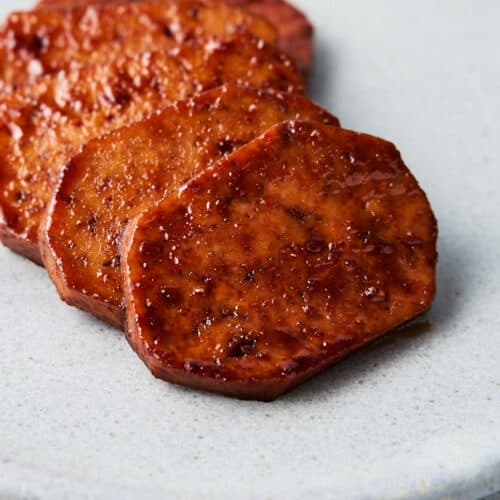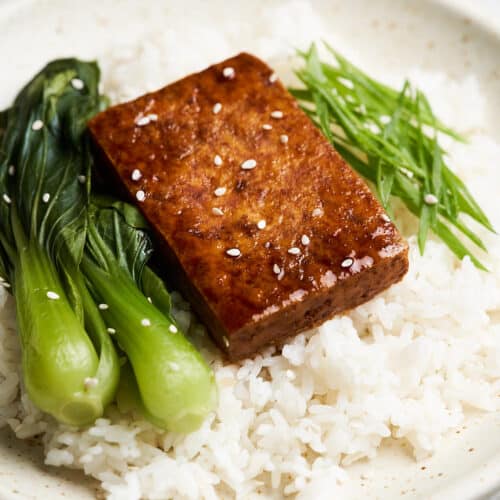Vegan Fish
This vegan fish recipe features hearts of palm, nori, panko, and Old Bay seasoning. Dunk these crispy, crunchy fillets in vegan tartar sauce or serve them alongside homemade “chips” for a classic British meal made plant-based!

From start to finish, this vegan fish dish is ready in under an hour. Thanks to classic (and some creative) seasonings, it’s not short on flavor. These fish sticks are also the perfect pair for homemade vegan tartar sauce!
Why I love this recipe
What’s not to love about a recipe that transforms plant-based ingredients into something that emulates the taste and texture of traditional beer-battered fish? Store-bought vegan options are typically made from wheat protein that’s been processed with a liquid and thickened.
From there, it’s tossed with seasonings, molded into a fillet shape, coated in batter, and fried. For this vegan fish recipe, I keep things much simpler and healthier with a hearts of palm base and a simple beer batter.
The end result? Crispy on the outside and tender on the inside with a hint of the ocean. Trust me when I say this is a crowd-pleasing dish that’ll have everyone asking for seconds. Served with chips, it’s even a fun finger food for little ones!
Ingredient notes
The great thing about this vegan fish recipe is how budget-friendly each of the ingredients is. Find a breakdown and suitable substitutes below!

Hearts of palm
To create a flaky, fish-like texture, I trust canned hearts of palm! You can find this vegetable in the canned vegetables aisle of large grocery stores or Asian food markets.
Substitute: If you can’t find hearts of palm, canned artichoke hearts, canned young jackfruit, and canned banana blossoms work as well.
Breadcrumbs
I use regular panko, but you can also use gluten-free panko to provide texture and bind the filling.
Substitute: If you don’t have panko, use an equivalent amount of crushed saltine crackers and reduce the salt in the rest of the recipe.
Nori sheets
Roasted seaweed sheets give this recipe a distinct “fishy” taste. These can usually be found in most grocery stores, but you’ll definitely be able to find them in Asian food markets.
Seasonings
Old Bay seasoning, garlic powder, onion powder, salt, and black pepper add classic seafood flavors, just like the real deal.
Substitute: For a slightly more vibrant taste, replace regular black pepper with lemon pepper.
Batter
I use a mix of all-purpose flour and cornstarch to create a crispy, golden-brown crust. The cornstarch is key in preventing the coating from becoming soggy. I also add baking powder to lighten the batter and make it extra tender.
Substitute: A 1:1 gluten-free blend can be used instead of all-purpose flour.
Beer
The CO2 in beer also creates an airy batter texture. My go-to variety is Modelo, but you can use any light-colored beer.
Substitute: If you’d like to keep this recipe non-alcoholic, use sparkling water instead.
For a complete ingredient list and step-by-step guide, scroll down to our recipe card.
How to make
Learn the best way to make vegan fish with my straightforward, easy-to-follow instructions. Look for the tips in green throughout this section for consistent and successful results!
Cooking
Step 1
Add the hearts of palm, panko, nori, and seasonings to the bowl of a food processor. Pulse until the mixture sticks together.
Leave some chunks rather than fully blend the mixture into a paste to better emulate fish sticks.


Step 2
Line a baking sheet with parchment paper. Measure out 3-4 tablespoons of the fish mixture at a time and shape it into a “fish fillet” shape with your hands. Place the fillets on the prepared baking sheet, then transfer the sheet to your fridge to chill.


Step 3
Pour several inches of oil into a deep pot and heat it over medium. In a large mixing bowl, whisk flour, cornstarch, baking powder, garlic, onion, Old Bay, salt, and pepper. Slowly pour 1 cup of beer in and stir until a pancake-like batter forms.
You may need to add slightly more beer, but start with a small amount.


Step 4
Once the oil has reached 350-375 degrees Fahrenheit, remove the fish fillets from the fridge and dip them into the batter. Use a fork to flip the fish filets over.
Ensure the fillets are completely coated to prevent them from falling apart in the oil.


Step 5
Transfer the battered fish to the pot of hot oil. Working in small batches of 2-3, fry your vegan fish for 2-3 minutes per side until they’re golden brown.

Step 6
Transfer cooked vegan fried fish fillets to a wire rack over a baking sheet or a paper towel-lined plate to absorb excess oil. Once slightly cooled, serve with your favorite dipping sauce. Happy eating!

Expert tip
The consistency of the batter can really make or break your vegan fish fillets. If it’s too thick, it won’t properly coat the fillets. It will also be unpleasantly chunky with clumps of dry flour.
If it’s too thin, it will slip right off the fillets as they cook. When you’re whisking in the beer or sparkling water, aim for a similar consistency as pancake batter.
My suggestion is to start with a smaller amount than you think you’ll need, whisk the batter, and then add more gradually until you reach the correct consistency.
Cooking tips
Handle gently: The fish fillets are delicate, so handle them with care when dipping them in the batter. It’s best to use a couple of forks!
Measure your fish mixture: Do not use more than 3-4 tablespoons at a time for each fish stick. If you do, they will be too heavy and won’t fry properly.
Work in batches: Lay the fish fillets in a single layer on the pan, leaving room between them. Fry them in batches so they are not overcrowded in the pot. Nobody wants soggy fish and chips!
Use the right beer: For a perfectly flaky batter texture, opt for a light beer and make sure it’s ice-cold!
Use a thermometer: Use a deep-fry thermometer to make sure the oil is hot enough and maintains a consistent temperature throughout cooking.

Frequently asked questions
Beer boils off at a temperature of 212 degrees Fahrenheit. However, given that this vegan fish is cooked fairly quickly, some of the alcohol will remain. For an alcohol-free option, use sparkling water.
Yes, you can shape the fillets and store them in the refrigerator up to a day in advance. Batter and fry them just before serving to keep the texture crispy.
Make sure the oil is hot enough before frying, and avoid overcrowding the pan. Gently place the fillets in the oil and flip them carefully.
If you don’t have Old Bay, make a substitute using equal parts of celery salt, paprika, ground black pepper, and a pinch of cayenne.
Storing & reheating
It’s ideal to consume vegan fish fresh for the crispiest texture. However, if you find yourself with leftovers, let the fillets cool before storing them to prevent moisture buildup.
Fridge
You can keep these vegan fish fillets in the fridge. Place the cooled fillets in an airtight container and refrigerate them for up to 2-3 days.
Freezer
Freezing is also an option for longer storage. Arrange the cooled fillets on a baking sheet to freeze them individually, then transfer them to a freezer-safe bag or container. They can be frozen for up to 1 month.
Reheating
It’s best to use an air fryer or oven to keep the fillets crispy. Preheat the air fryer to 350 degrees Fahrenheit or oven to 375 degrees Fahrenheit. Heat them for 10-15 minutes from the fridge or 20-25 minutes from frozen, flipping halfway through.
More vegan meat replacements
Hungry for more?
If you enjoyed this recipe, please consider leaving a star rating and a comment down below! Your feedback not only helps others discover our blog but also gives us valuable insights from your experience.
Don’t forget to subscribe to our newsletter for the latest recipes, and check out our shop for our top kitchen recommendations. Thank you for supporting BBV!
Recipe

Crispy Beer-Battered Vegan Fish
Equipment
- Food processor
- Large mixing bowl
- Baking sheet
- Deep pot
Ingredients
Fish
- 1 15-ounce can hearts of palm, drained & quartered
- ½ cup panko bread crumbs
- 1 teaspoon crumbled nori sheets
- 1 teaspoon Old Bay seasoning
- ½ teaspoon salt
- ½ teaspoon black pepper
Batter
- 1 cup all-purpose flour
- ½ cup cornstarch
- 1 teaspoon baking powder
- 2 teaspoons garlic powder
- 1 teaspoon onion powder
- 1 teaspoon Old Bay seasoning
- ½ teaspoon salt
- ½ teaspoon black pepper
- 1 cup light beer, plus more as needed
For frying
- ~1-2 cups neutral vegetable oil
For serving
Instructions
Fish
- In a food processor, pulse the hearts of palm, panko, nori, Old Bay seasoning, salt, and pepper until the mixture sticks together. Be careful not to mix too much as you want some chunks left behind.
- Line a baking sheet with parchment paper, then measure out about 3-4 tablespoons of the mixture. Use your hands to form a fish fillet shape, and place the fish on the parchment-lined pan.
- Repeat the same process until all the mixture is gone (you should get about 5-6 pieces out of this recipe). Transfer the tray of vegan fish fillets to your fridge while you prepare the batter.
Batter
- Add a few inches of oil to a deep pot, and heat it over medium. Use a deep-fry thermometer for the most consistent results.
- Whisk the flour, cornstarch, baking powder, garlic powder, onion powder, Old Bay seasoning, salt, and pepper together in a large mixing bowl.
- Stir in 1 cup of beer/sparkling water, or enough to create a pancake batter-like consistency. Add more beer 1 tablespoon at a time until you achieve the right consistency.
Frying
- Once the oil temperature reaches 350-375°F (or a piece of batter floats to the top), dip the fish fillets in the batter and cover all sides.
- Pick them up with a fork to drain excess batter, then add them to the pot. Fry in small batches for 2-3 minutes per side, or until golden brown.
- Transfer to a wire rack over top of a baking sheet, or a paper towel-lined plate while you fry the rest. Serve warm with a side of vegan tartar sauce. Happy eating!
Notes
Nutrition
Note: I’ve updated this post to include new information and helpful tips about the recipe.
Mitch Chapman is a food writer, photographer, and one of the founders of Broke Bank Vegan. With a background in healthcare and the restaurant industry, he has a passion for sharing healthy yet flavorful plant-based food.





Good afternoon: I have been on a Vegan fish cak mission the past couple of weeks. I have tried 3 out of the 4 recipes and yours is the best so far. Thank you. Question: can I freeze or refrigerate the left over batter if so dor how long?
Marcia – Harlem NY
Hi Marcia,
That’s so great to hear! We are glad you enjoyed the recipe 🙂 Yes, you should be able to freeze the uncooked batter for up to a month!
I really enjoyed this recipe!! Thanks so much for sharing!
Hey Jen,
We are so glad you liked it! Thanks for leaving a comment 🙂